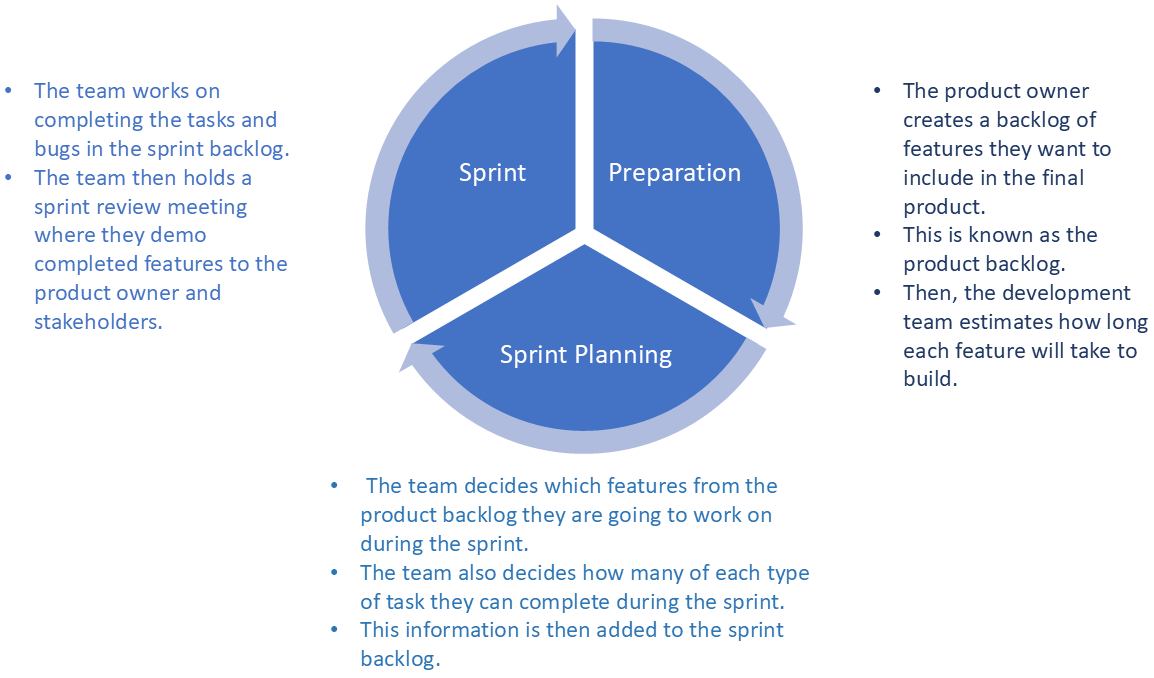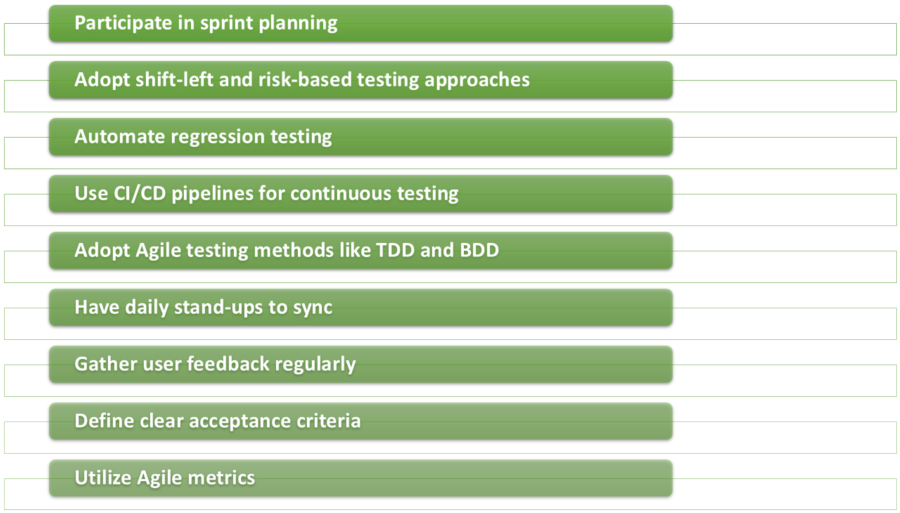The Role of QA in Agile Development
|
|
Quality Assurance (QA) has evolved significantly in recent years, especially with the widespread adoption of Agile methodologies. In the fast-moving world of software development, where rapid iterations and continuous delivery are the norm, QA has become an integral part of the development process rather than a separate afterthought activity.
According to a study, companies achieved 60% higher revenue growth with Agile. This trend can be attributed, in part, to the enhanced role of QA in Agile environments.
In this post, we will explore how QA fits into Agile development and its benefits.
What is Agile Development?
Agile development is an iterative and incremental approach to software development that focuses on:
- Iterative process
- Customer collaboration
- Cross-functional teams
- Embracing change
- Continuous improvement
Agile development has gained widespread popularity due to its ability to adapt to changing requirements, deliver value quickly, and improve overall software quality. It has been successfully adopted by organizations of all sizes in various industries, including technology, finance, healthcare, and manufacturing.

Why is Everyone Moving to Agile?
Due to the flexible nature of Agile methodologies and their proven results, you’ll see most organizations opt for it. Here’s why:
- Changing customer needs: Businesses today operate in dynamic environments where customer needs and market conditions can change rapidly. Agile allows teams to adapt to these changes quickly and effectively.
- Competitive pressure: Organizations must innovate and deliver products or services faster than their competitors to stay relevant. Agile methodologies enable faster time-to-market.
- Continuous testing: Agile emphasizes early and continuous testing which allows teams to identify and address defects earlier in the development cycle. This ultimately leads to higher-quality products.
- Incremental delivery: Agile methodologies focus on delivering small, functional increments of software frequently. This allows businesses to launch products faster and iterate based on user feedback.
- Reduced risk: By breaking projects into smaller parts, Agile reduces the risk associated with large-scale projects and allows teams to pivot as needed. Read about risk-based testing.
- Frequent feedback loops: Regular feedback and reviews help identify risks and issues early which allows teams to address them proactively rather than reactively.
- Interconnected systems: Modern projects often involve complex systems with many interconnected components. Agile methods facilitate collaboration among different teams and ensure that changes made in one area do not have unintended consequences in others.
- Early detection of defects: Agile methodologies emphasize continuous testing and feedback which helps to identify and address defects early in the development process.
- Higher customer satisfaction: By delivering working software incrementally and gathering feedback, Agile teams can ensure that the final product meets the needs of customers.
Transformation of QA in Agile
In Agile development, you will see QA is transformed from a final checkpoint to a continuous, collaborative process integral to the development lifecycle. As a result, QA in Agile is more proactive and integrated. This ensures that high-quality software is delivered continuously and efficiently.
Here are the key changes that QA has undergone to keep up with Agile:
Shift from gatekeeping to collaboration
In traditional methodologies (like Waterfall), QA often served as a gatekeeper, testing the product after development was complete. In Agile, QA is integrated throughout the development process by collaborating with developers from the start to ensure quality is built in rather than inspected in.
Involvement in planning
You will see that QA professionals in Agile participate in sprint planning, defining acceptance criteria and understanding user stories. This early involvement helps to clarify expectations and ensure alignment between development and quality goals.
Continuous testing and feedback
Agile is all about speed and efficiency. Thus any activity that needs to happen during a sprint cycle, needs to happen fast. Hence, to ensure quality, different techniques are used like:
- Automation: Agile emphasizes continuous testing, often supported by automated testing frameworks. This allows QA to provide rapid feedback to developers and helps catch defects early in the development cycle.
- Test-Driven Development (TDD) and Behavior-Driven Development (BDD): Agile encourages practices like TDD and BDD, where tests are written before the actual code. This leads to a focus on requirements and ensures that testing is closely aligned with user expectations.
Cross-functional teams
In Agile, quality is a shared responsibility among all team members, rather than solely the responsibility of QA. This promotes a culture of collective ownership and encourages all team members to contribute to quality efforts. QA professionals work closely with developers, product owners and other stakeholders to foster open communication and collaboration to address quality issues in real-time.
Emphasis on customer feedback
Agile methodologies focus on delivering small increments of working software frequently. This allows for rapid customer feedback, which QA teams can use to refine testing processes and improve the overall product quality. QA teams often facilitate or conduct UAT during sprints to engage end-users to validate that the software meets their needs and expectations.
Flexibility and adaptability
Agile allows QA teams to adapt to changing requirements easily. Since Agile projects are iterative, they can modify test cases and strategies based on the latest information to ensure that quality checks remain relevant. Agile emphasizes retrospectives where teams reflect on their performance, including quality practices. This encourages ongoing improvement in QA processes and methodologies.
Challenges for QA in Agile
The iterative and collaborative nature of Agile presents some unique challenges to QA.
- Rapidly changing requirements: Since Agile methodologies embrace change, it can lead to shifting requirements. QA must be adaptable and ready to revise test plans and cases regularly, which makes it challenging to maintain comprehensive documentation.
- Impact on testing: Continuous changes can complicate the testing process and require QA teams to frequently update test scenarios and retest existing functionality.
- Balancing speed and quality: Agile sprints are typically short (1-4 weeks), which can create pressure on QA teams to execute thorough testing within tight timeframes. If not managed effectively, this can lead to potential quality compromises.
- Automation challenges: While automation is crucial for continuous testing, creating and maintaining automated test scripts can be time-consuming and require skilled resources. Moreover, integrating testing tools with development tools (e.g., CI/CD pipelines) can pose challenges, especially in environments with varying technologies and frameworks.
- Collaboration and communication: Though Agile promotes collaboration across roles but differences in perspectives and priorities between developers, QA and product owners can lead to misunderstandings and conflicts. Ensuring that all stakeholders, including non-technical users, are engaged in the testing process and provide timely feedback can be challenging.
- Cultural shift: Transitioning to Agile requires a cultural shift within organizations, where quality is seen as a collective responsibility rather than the sole duty of the QA team. This can take time and effort to instill in team members. Some team members may resist adopting Agile practices or may be accustomed to traditional QA roles, which can make it challenging to adopt a collaborative quality culture.
Best Practices for QA in Agile

Importance of Good Test Automation Tools
To make Agile successful for your organization, you need to use automated testing. To do this, you need to use test automation tools that make your job easier by eliminating problems like:
- Requiring special automation engineers or skills to automate tests. This creates dependency and budget considerations since one will then need to hire suitable engineers.
- Steep learning curve, in terms of using the tool. If the tool requires you to code in a programming language and you aren’t able to, then that’s a problem.
- High test maintenance overhead.
- Flakey test runs. Many test automation tools cannot handle dynamic UI elements in the application under test. Or these tools simply do not offer stable solutions for executing test cases.
You need to look for a test automation tool that is suitable for your team and project requirements. Luckily, there are some good alternatives out there, but the one that outshines them all is testRigor.
QA in Agile Development with testRigor
testRigor is the closest you can have to a machine emulating a human tester. It is the perfect solution for testing UIs, functionalities, or doing end-to-end and regression testing. With this tool, you needn’t worry about the learning curve. Writing test cases in testRigor is as simple as writing them in plain English language, like you would write manual test cases. This is made possible due to the tool’s use of generative AI and ML. Thus, anyone, be it a developer, tester or product owner, can write test cases.
That’s not all. You can automate complex cross-platform and cross-browser scenarios in a jiffy. Executing them is also not a problem as testRigor ensures stable test runs. One major reason this tool can guarantee this is because of its independence from implementation details (like XPaths and CSS tags) of UI elements.
“What you see is what you write” when it comes to testRigor!
In Agile environments where speed and accuracy are of utmost importance, testRigor can thus give you the best results in the quickest of time.
Summing it up
When it comes to QA in Agile, you can sum it up by saying – “test early, test often”.
Irrespective of which methodology you use, QA is going to be an integral part of it. Especially in an environment where top-class speedy deliveries are of the essence. Hence, if Agile is your way ahead, then you need to figure out and plan how to incorporate QA into the process.
| Achieve More Than 90% Test Automation | |
| Step by Step Walkthroughs and Help | |
| 14 Day Free Trial, Cancel Anytime |












